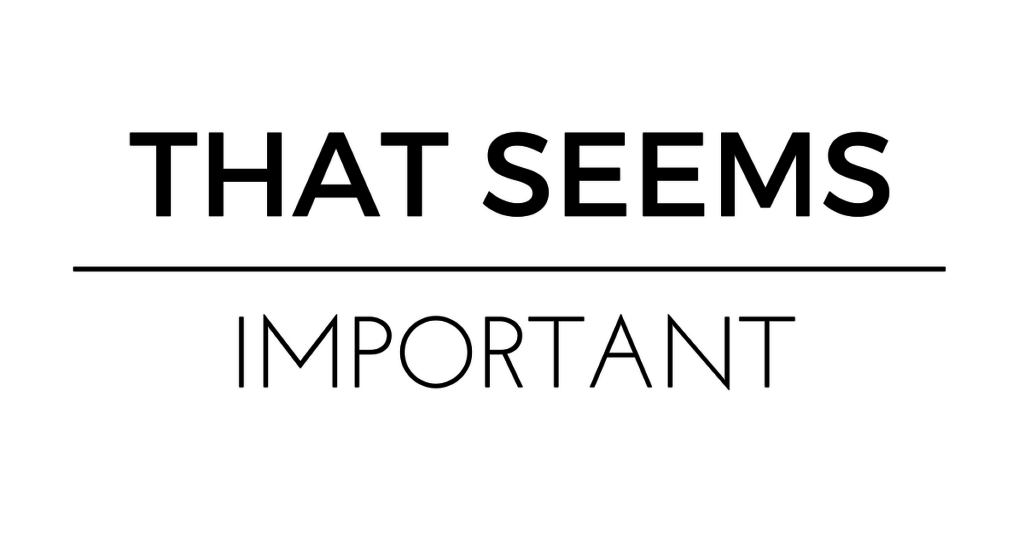“Are you afraid of the impending robot revolution or do you feel completely safe and not at all worried about A.I. technology?”
That wasn’t a joke. A real surveyor for a real (and prestigious!) institution asked me this.
A pollster called my landline and I agreed to “answer a few brief questions on the economy.” Highly highly recommend you take telemarketers’ and pollsters’ calls if you’re having a slow night and need some entertainment. You will not be disappointed.
If you have a brain, you know this is a bad question.
It’s a bad question because answering it doesn’t tell you anything useful.
Market research is overflowing with bad questions (Why? that’s for another post). I know because I started my career in research. Surveys, assessments, phone screens, rating scales, in-depth interviews, focus groups, you name it, I did it.
If you’re writing a customer survey it’s because you are looking for information to help you grow your business. You want to get in the mind of your customer and walk around in there for a while.
Unfortunately, most of what you’ve seen (and are probably copying) is wrong and bad and won’t help you. Ergo, robot revolution question.
To avoid doing what everyone else is doing wrong, here are the 10 things you need to do to write a good customer survey:
1. Cut the intro.
No one reads them. If someone is filling this out for you, they have a job and a life too. They don’t care why you wrote it, what you were inspired by, what you hope to find, and that you’re sorry it’s so long.
If you must write something, keep it no longer than a line. But I recommend putting that fluffy preamble in your email where you ask them to fill out your survey in the first place. Except, I’d cut the fluff parts and say what you mean and keep it short.
Your survey-takers have a life. They aren’t reading this part.
2. Keep questions open-ended.
No one likes to sift through your 67-different-combinations-of-offerings squinting to read each one. And everyone hates Likert Scales.
I know you’re trying to get statistically sound data you can analyze in fun ways, but let’s be real here – you’re not actually going to do that at this stage in the game. If you’re getting to know your customers, you’re getting qualitative data.
You need directional info and you need the juicy nuggets that come from a good ole fashioned brain dump. You want the rambling. You want the asides. You want ALL OF IT. Don’t argue with me on this.
The more information you can get from your customer – how she thinks about the problem you solve, and what assumptions she makes about the world, what keeps her up at night – the better. The best way to do that (save for a face-to-face conversation) is to ask open-ended questions and let her ramble. You’re not looking for statistical significance, you’re looking for the truth.
Ask open-ended questions. Nothing else.
3. Resist the urge to ask leading questions.
Leading questions are questions that influence the answer. Which is great if you have a boss and you’re trying to confirm his or her bias so you can get promoted. But it’s not so great if you want to get actual sales. (or if you care about integrity in research but…psh, who cares about that?)
Leading question: Do you have problems with your boss?
Better question: Can you describe your relationship with your boss?
Leading question: Do you agree that polluting is bad?
Better question: How do you feel about pollution?
Leading questions are great if you run a media company and want to give misleading statistics that give you more viewers, like “59% of people are afraid of an impending robot revolution.”
4. Resist the urge to ask yes/no questions.
This relates to numbers two and three, but deserves it’s own bullet because we often don’t realize we’re doing it. “Yes/no” questions are not that helpful unless you sincerely need to know yes or no.
If it wasn’t already clear: YOU WANT MORE INFORMATION THAN YES OR NO!
You want to know why, how, when, where, what, whose fault was it, what did they say, how did it make you feel, etc.
“Do you like coffee?” is not a helpful question if you’re launching an artisanal coffee subscription company. “Why do you drink coffee?” or “What do you like about coffee?” will give you much better answers.
To keep yourself in check, ask yourself: Could the respondent answer only “yes” to this question and feel like they answered the question?
“Do you drink coffee?” Yes.
“Why do you drink coffee?” Yes. (sounds weird)
“What do you like about coffee?” Yes. (sounds weird)
Go with the ones that sound weird when you answer “yes.”
5. Use answer prompts sparingly.
Answer prompts are helpful for giving respondents a starting point to answer your question, but because they are helpful they also tend to cloud your respondent’s ability to be objective and come up with their own answer.
Exhibit A:
“What do you think of when you think about Margo?”
Red hair, wine, stilettos, etc.
Exhibit B:
“What do you think of when you think about Margo?”
Kindness, compassion, benevolence, etc.
Seems benign, but those two prompts take respondents into two totally different places. One is a bit goofier and related to physical items she’s associated with. The other is emotional states.
For example, perhaps you want to capture the physical items Margo is associated with because you’re a graphic designer and you need visual answers, not the emotional states. Or, conversely, you want to capture emotional states because you’re a graphic designer and you’re creating a color palate for Margo that needs to embody those traits.
Depending on what you’re asking the question for, either prompt could be helpful. But if you want to capture pure guttural reactions – don’t put a prompt unless necessary.
Times when a prompt is necessary:
You think your survey-taker will misunderstand the question.
You think your survey-taker will go in the wrong direction with the answer.
One last example, if you want to clarify instructions, but not give an answer, you can do something like this:
Exhibit C:
“What do you think of when you think about Margo?”
Can be anything that comes to mind. Don’t censor yourself here. There’s no “wrong” answer.
6. Create an atmosphere for honesty.
People care what you think. Make sure they know the survey is anonymous, that you appreciate the feedback, and this is a judgement-free zone. Come at it like a scientist. You’re trying to capture the truth of what your prospect is feeling, seeing, and behaving. It helps no one if they lie (which they’re doing anyway, see #10).
This has a significant influence on answers. It’s why focus groups are pretty useless. You want honest answers, otherwise, you won’t have information that helps you grow your business and sell more.
Consider the person who is balding. You have a conditioner that can help. The balding person is not going to tell you they perused the “toupee” section on Amazon unless they feel safe and not judged. But you need to know that they are looking for toupees! That’s really valuable information that can inspire blog posts, ad campaigns, headlines, and media planning (where you place an ad – like in the toupee section vs the hair color section).
You can bolster that this survey is a safe-zone in your email: “Responses are totally anonymous. Be blunt and honest. Don’t just give me what I want to hear.” And btw that should also be true. Don’t be an ass and track responses if you’re telling people it’s anonymous.
7. Ask 3-6 questions tops. TOPS.
Market researchers all over the world are yelling at the computer right now. They can yell all they want but it doesn’t change the facts: no one enjoys filling out surveys. No one. It is fun for no one.
So how do you get people to do something they don’t like? You compromise.
You want honest answers to help you understand your customer.
Your respondent wants to go back to her life and not be bothered by your survey.
3-6 questions are the compromise. You get to capture some strong qualitative rambling data (wahoo!) and your respondent gets to go back to their life.
Put yourself in their shoes. How much do you like getting a survey from BlueCross BlueShield with 35 questions they promise will only take 15 minutes (it never takes 15 minutes). You’re just hitting buttons by the end to make it stop and you can be entered in a raffle to win an iPad.
Which brings me to #8.
8. Do not offer an incentive in return for filling out your survey.
This is the worst part of the market research industry. Incentives immediately change the nature of the exchange. It becomes about the $50 or FREE yoga class or iPad raffle and not the information. Now, incentives are fine if you’re doing something in the hard sciences because you aren’t totally reliant on self-reporting (which is what a survey is). If you’re taking blood or saliva swabs from someone, it doesn’t really matter why they are there. Incentives won’t change the composition of their blood or saliva.
But incentives will influence how your respondents answer your qualitative questions about how they feel, think, and behave. This is the plight of the social sciences. If you’re a social scientist reading this, you know what I’m talking about. If you’re not here’s what you need to know: appealing to people’s humanity is enough to get them to fill things out for you.
I’ve gotten hundreds (yes, hundreds) of people I’ve never met to get on the phone with me and answer some questions or fill out a survey. I know this works. People like helping people they believe in and that they think will actually listen. And people love love love to talk about themselves. If you communicate that you care about this topic and REALLY care about this person’s opinion/feedback (which you should. And if you don’t, go away. I cannot help you.) you can get them to fill out your survey.
This isn’t rocket science. Be genuinely curious and be respectful of people’s time. You’d be amazed how much you can get out of someone if you ask nicely.
9. Do not send surveys to your friends and family.
This isn’t exactly about how you write a survey, but this affects the outcome of your survey big time, so I snuck it in. You’re welcome.
There are only two reasons to ever ask your friends for anything
Reason 1) To get information on you personally (i.e., “What are my strengths?”). They can articulate things about you better than you can and see you from a different angle than you see yourself. This is helpful if you’re doing a personal branding survey, for example.
Reason 2) They happen to be your market. If you’re targeting new moms and you have 6 friends that just had babies – cool. Send them a customer survey. But if you’re targeting new moms who love yoga and working out and your friends sit on the couch and eat Oreos all day, then their feedback won’t be helpful to you.
How do you know if your friends and family are your market? You want to find out if they’ve bought products or services like yours in the past or if they have the problem your product solves (they suffer from sweat stains and you’re selling sweat-free fabric T-shirts. They just started weight watchers and you are a health coach. They love reading books on parenting and you have a book on parenting. You get my point.).
The time to use friends and family is in promoting your business, not in collecting customer insights.
10. Listen to what people do, not what they say.
Your respondents are liars. All of em. They’re not lying on purpose per se. They’re mostly lying to themselves, but it’s still lying.
We have little-to-no self-awareness as to why we buy what we buy or do what we do. We don’t know why we do things, we just do them.
To avoid getting crap data, you want to learn to ask questions that focus on behavior and not explanations or rationalizations for behavior (unless you’re trained to see through that and know the difference, which is really hard to do).
A very popular question that leads to answers where people lie is this: “How much would you be willing to pay for a product like this?”
The answer to that question is not at all predictive of actual behavior. You would never spend $7.75 on a magazine because that is way too much, plus who the heck buys magazines? You did. You bought one at the airport because you forgot your book, your phone battery died, and you were so freaking bored and Chris Hemsworth is so freaking hot.
Better questions: “When was the last time you bought a print magazine?” or “How much did you pay for the magazine?” “Have you ever spent more than $7 on a print magazine? And if so, when?”
I still like to ask why. It’s really interesting to hear how people rationalize their behavior. Just remember, any answer you get is an after-the-fact rationalization. You want to tap into what they were thinking before it was rationalized. “I was bored at the airport” is not enough. You want to know they were bored and they were pissed and they like Chris Helmsworth.
That way, for example, when you decide where to physically sell your magazine you can make sure you choose places in areas without cell phone chargers where people are more likely to have their phones die. Or when you decide to place an ad somewhere, you can lead with your good looking page covers instead of your more interesting stories. Etc…
Remember, the goal of a customer survey is to get in your customer’s head. You want to capture the thoughts, feelings, and behavior of your market as accurately as you can.
It will do your business no good to get anything different. Even if it’s how they feel about the impending robot revolution. As long as it’s honest, then you’ve gotten what you came for.




